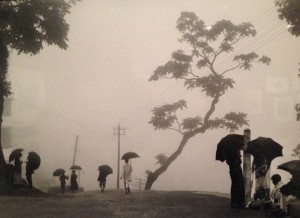Darjeeling, 1956
As explained in the description, Riboud took this photograph in Darjeeling which is a famous hill station at the bottom of the Himalayas. He, as I am sure many are, was intrigued by the diversity of its inhabitants that included Tibetans, Chinese, Sikkimese, and Nepalese. Personally, what drew me to this photograph apart from it’s impecable composition and aesthetics, was my adoration for Wes Anderson and his well-known film, “The Darjeeling Limited”. The photograph was a very mystical quality to it, it is almost like it has texture. The fog, along with the depth, and the umbrellas, portray almost a surreal feeling. It leaves you wanting more, to discover what is under the fog. After a bit of research I got to the bottom of the historical and social confusion that had happened in the area, and why there was such diversity of inhabitants. Darjeeling had been under British rule as part of India and used as a military base, as well as a center for travel and commerce. After India’s independence in 1947, and partition in the years after, the region faced several changes from becoming part of Occidental Bengal to becoming it’s individual district. During the time of partition it became home to many bengali refugees. During the time that Riboud was in Darjeleeing, the majority of ethic nepali’s were asking for autonomy and the adoption of the nepali language (which was not granted until 1961). Riboud, I am sure, aware of the situation wanted to portray the confusion, and the historical timeless quality of the place. He wanted people to know, from what I can put together, that there was more to Darjeeling than it’s travel and commerce. He wanted to show the local’s perspective of the place, their struggles and realities instead of the typical tourist experience.
